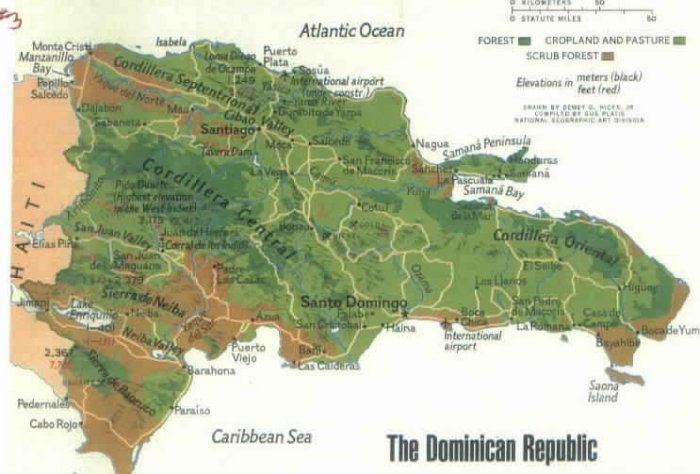
Related Links
American Baptist Churches-International Ministries
Dominican Culture
Las
Culturas
Travel
Facts
dr1
|
|
Dominican
Republic
|
|

Occupying
the eastern two-thirds of the island named Hispaniola, the Dominican
Republic is a beautiful country with one of the longest histories in
the New World. Although inhabited originally by native Taino Indians,
Hispaniola was discovered by Christopher Columbus in 1492. A year later,
he established the first European colony in America - La Isabela. After
several hundred years, the island is now shared relatively peacefully
by the nations of Haiti and the Dominican Republic.
History
The Dominican Republic, whose capital is Santo Domingo, is home to over
8.5 million people and covers just under 19,000 square miles of the
island of Hispaniola. Much of the DR's past concerns power struggles
between the colonial presences of Spain and France, as well as between
the sovereign states of Haiti and the Dominican Republic. Originally
exploited for its gold, Hispaniola quickly lost the interest of Spanish
colonists when the mines began to run dry. Then, in the late 17th century,
France took control of the western third of the island. For the next
century, France developed this colony into the richest in the world
- the wealth based on sugar production. The harvest and refining of
sugarcane into sugar was carried out by African slaves who had been
imported into the country.
In the late 18th century, following a slave revolt on the western third
of the island, France abolished slavery. French and former-slave forces
then attacked and occupied the eastern part of Hispaniola, bringing
the Spanish colonies under French control. Control of the Dominican
Republic was returned to Spain several years later - and thus began
a pattern of back-and-forth that would last until 1844.
(top)
On February 27, 1844, the Dominican Republic officially declared its independence from Haiti. Although the borders never again shifted, unrest between the two nations would remain for many years. During the next chapter of its history, lasting some 70 years, the Dominican Republic experienced a series of civil wars punctuated by short periods of peace. Presidents and dictators leading the country were often corrupt and more often power-hungry. This instability paved the way for an American occupation of the country, which lasted from 1916-1924.
In 1930, one of the most vicious eras of the Dominican Republic began, when Raphael Leonidas Trujillo took power. By utilizing secret police, consolidating power, and essentially ruling the country with an iron fist, Trujillo led the country to a period of economic boon. As a consequence, however, civil liberty was quite demolished. In 1961, Trujillo's dictatorship was brought to an end with his execution.
Since
Trujillo's reign, the Dominican Republic has been an essentially democratic
country. Early presidents were guilty of corruption and nepotism, but
recent politicians have been upstanding and refreshingly progressive.
Presidential elections are held every four years. The next presidential
election will be held May 16, 2004.
(top)
Economy
The economy
of the Dominican Republic is based primarily on tourism and sugar refining.
The gross domestic product of the country is around US$45 billion. The
dependence on tourism is quite evident in La
Romana, which serves as a port-of-call for cruise ships from around
the world. The coastline is spotted with resort hotels, and an entire
industry has been erected around foreign travelers.
(see Dominican
Republic Facts)
|
|
Culture
Looking at the history of the Dominican Republic, it is easy to see
that Dominican culture is a melting-pot of backgrounds. Indian, slave,
Spanish, and French influences have all played a role in developing
the religion, music, food,
and other cultural traditions of the country. Officially, the Dominican
Republic is 95% Roman Catholic. Other religions include other Christian
denominations, small pockets of Judaism, as well as Haitian Voodoo.
Popular music in the Dominican Republic is of three main types: merengue, bachata, and salsa. The music scene in the country is also strongly influenced by American pop.
Dominican food, sometimes surprising to travelers, is not spicy like other Caribbean cuisine. The Bandera Dominicana, or traditional meal, is white rice with stewed beans, stewed meat, and a side or salad. This is traditionally served at lunch, which is normally the heaviest meal of the day. This could explain why most everything in the country shuts down over the lunch hours, from noon until 2:00 PM.
Fun
Facts 
The Dominican preoccupation with baseball is most likely an artifact
of the American occupation, during and after the first World War. Baseball
is played in every corner of the country; in La Romana, the sugarcane
fields are dotted with baseball diamonds. Also, many American major-leaguers
return to the Dominican to play in the off-season.
The DR has been
home to several Hollywood film crews. The Chavon river, which runs through
the eastern part of La Romana, subbed for the African coast in Apocalypse
Now. Additionally, the old city in Santo Domingo served as Cuba for
the filming of the Godfather Part II.
The capitol,
Santo Domingo, was home to the 2003 Pan-American Games.
Santo Domingo also
hosted the NBA's first overseas exhibition match in 2003, with the then
current president, Hipólito Mejía tossing up the tip-off.
National elections were held on May 16, 2004. The opponent of the current president, Hipolito Mejia, won the election by almost 20% of the votes. The new president is Leonel Fernandez of the PLD party. For more news about elections (in spanish), go to www.jce.do (the official elections webpage) or dr1 (in english) which offers information and updates on the current elections.





